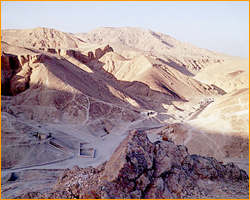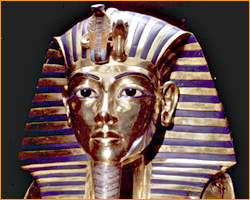 We can imagine the careful plotting1 beforehand2, the secret rendezvous in a desolate ravine3, quiet figures moving stealthily4 through the pitch-black5 Egyptian night. Frantic6 digging in the dark candles in hand, the robbers grab7 as much portable treasure as they can and slip away8 before the sun rises. Such robbery was unavoidable9. Every Egyptian knew the rich and powerful took treasure with them to eternity. Even one ornament from a pharaoh's sepulcher10 could keep a poor villager11 in food for years. The tomb12 robbers' nefarious13 trade was a silent war between loyal royal cemetery guards and those who preyed on the dead. No pharaoh was safe in his tomb, even Khufu, who built the Great Pyramid of Giza in 2550 B.C. Bold14 predators drugged15 or bribed16 guards and tunneled17 into the most inaccessible burial18 chambers.
We can imagine the careful plotting1 beforehand2, the secret rendezvous in a desolate ravine3, quiet figures moving stealthily4 through the pitch-black5 Egyptian night. Frantic6 digging in the dark candles in hand, the robbers grab7 as much portable treasure as they can and slip away8 before the sun rises. Such robbery was unavoidable9. Every Egyptian knew the rich and powerful took treasure with them to eternity. Even one ornament from a pharaoh's sepulcher10 could keep a poor villager11 in food for years. The tomb12 robbers' nefarious13 trade was a silent war between loyal royal cemetery guards and those who preyed on the dead. No pharaoh was safe in his tomb, even Khufu, who built the Great Pyramid of Giza in 2550 B.C. Bold14 predators drugged15 or bribed16 guards and tunneled17 into the most inaccessible burial18 chambers.
The royal tombs in the Valley of Kings near Thebes were comparatively19 sacrosanct20 during the reigns of the great pharaohs of the 18th and 19th dynasties, when Egypt was prosperous and a large force of guards supervised the royal sepulchers. By 1200 B.C., her kings were much weaker21. The custodians22 of royal tombs were lax, even corrupt. A wave of grave robbing enveloped23 Thebes. We know of this because a spectacular law case24 involving tomb robbing was heard during the 12th century B.C.

The case involved Paser, the mayor25 of eastern Thebes, an honest but rather officious local bureaucrat who became alarmed at the constant rumors of tomb robbing that came from the cemeteries on the west bank26 of the Nile. Perhaps he was anxious to ingratiate himself with27 higher authority, or to discredit his hated rival Pawero, mayor of Thebes of the Dead. Whatever his motive, Paser started an official investigation into tomb robbing, something that technically lay outside his jurisdiction. He soon uncovered28 all manner of disturbing testimony29 from actual30 eyewitnesses31 of grave robberies. A witness testified: "There we found the august32 mummy of the king. There were numerous amulets and golden ornaments at his throat33, his head had a mask of gold upon it." He watched the robbers strip34 the ruler of his finery35. Paser laid his case before the local vizier36, who sent an official commission to inspect the tombs. They found little out of order37. To Paser's embarrassment, his witnesses denied their earlier testimony. He had underestimated the degree to which his rival controlled the looting38.
Paser was a determined39 man. He continued to bombard the vizier with evidence of tomb robbing. A year later, even the highest officials could not deny that something was wrong. The vizier convened a new inquiry40. Forty-five tomb robbers were brought before the court and beaten on the soles41 of their feet to extract confessions. Their testimony survives, ironically on papyri42 looted and sold to 19th-century tourists. The incense roaster43 of the temple of the sun god Amun recounted how a group of robbers approached him. "Come out," they said, "We are going to take plunder44 for bread to eat." The priest described how the robbers broke into a royal tomb and divided the spoils45 into baskets. "The scribe of the Necropolis was examined with the stick46 [until] he said: 'Stop, I will tell.'" He confessed to the stealing of silver vases from a single tomb. When his memory faded47, he was examined again "with the birch48 and the screw49," but to no avail50. The case ended with savage punishments for the offenders51, which probably included death by impalement52. Not that the cases did much to stem53 the flood of robberies, for there are isolated mentions of later trials. The epidemic of looting was inevitable in a poverty-stricken54 country where wealth was for the few, more of it buried below ground than in the land of the living.